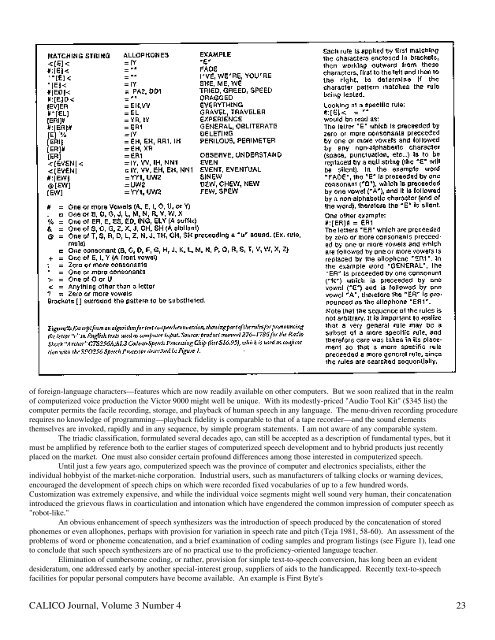MASTER (') S VOICE: THE VICTOR 9000 AND HIGH-FIDELITY ...
MASTER (') S VOICE: THE VICTOR 9000 AND HIGH-FIDELITY ...
MASTER (') S VOICE: THE VICTOR 9000 AND HIGH-FIDELITY ...
You also want an ePaper? Increase the reach of your titles
YUMPU automatically turns print PDFs into web optimized ePapers that Google loves.
of foreign-language characters—features which are now readily available on other computers. But we soon realized that in the realm<br />
of computerized voice production the Victor <strong>9000</strong> might well be unique. With its modestly-priced "Audio Tool Kit" ($345 list) the<br />
computer permits the facile recording, storage, and playback of human speech in any language. The menu-driven recording procedure<br />
requires no knowledge of programming—playback fidelity is comparable to that of a tape recorder—and the sound elements<br />
themselves are invoked, rapidly and in any sequence, by simple program statements. I am not aware of any comparable system.<br />
The triadic classification, formulated several decades ago, can still be accepted as a description of fundamental types, but it<br />
must be amplified by reference both to the earlier stages of computerized speech development and to hybrid products just recently<br />
placed on the market. One must also consider certain profound differences among those interested in computerized speech.<br />
Until just a few years ago, computerized speech was the province of computer and electronics specialists, either the<br />
individual hobbyist of the market-niche corporation. Industrial users, such as manufacturers of talking clocks or warning devices,<br />
encouraged the development of speech chips on which were recorded fixed vocabularies of up to a few hundred words.<br />
Customization was extremely expensive, and while the individual voice segments might well sound very human, their concatenation<br />
introduced the grievous flaws in coarticulation and intonation which have engendered the common impression of computer speech as<br />
"robot-like."<br />
An obvious enhancement of speech synthesizers was the introduction of speech produced by the concatenation of stored<br />
phonemes or even allophones, perhaps with provision for variation in speech rate and pitch (Teja 1981, 58-60). An assessment of the<br />
problems of word or phoneme concatenation, and a brief examination of coding samples and program listings (see Figure 1), lead one<br />
to conclude that such speech synthesizers are of no practical use to the proficiency-oriented language teacher.<br />
Elimination of cumbersome coding, or rather, provision for simple text-to-speech conversion, has long been an evident<br />
desideratum, one addressed early by another special-interest group, suppliers of aids to the handicapped. Recently text-to-speech<br />
facilities for popular personal computers have become available. An example is First Byte's<br />
CALICO Journal, Volume 3 Number 4 23
















